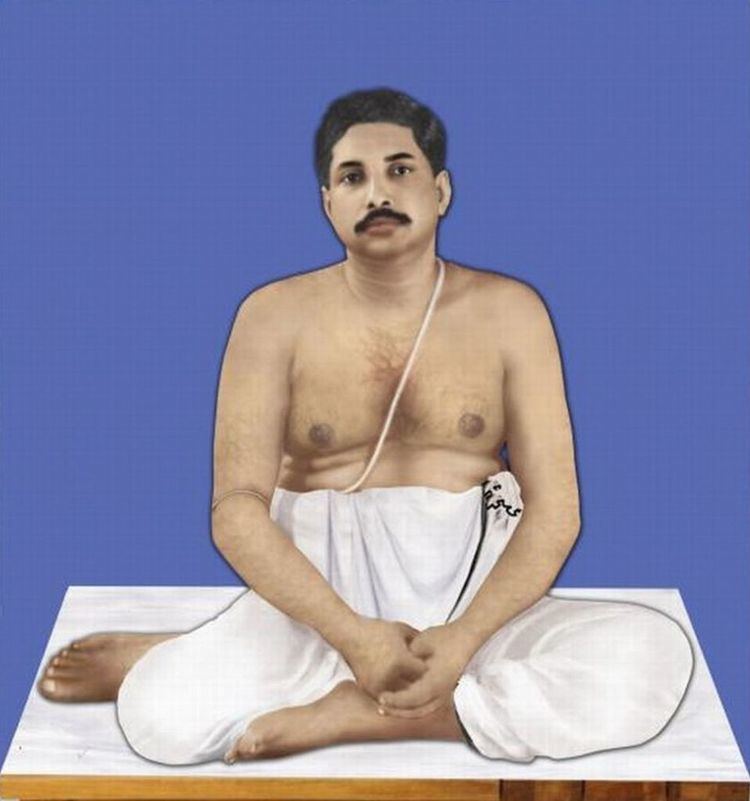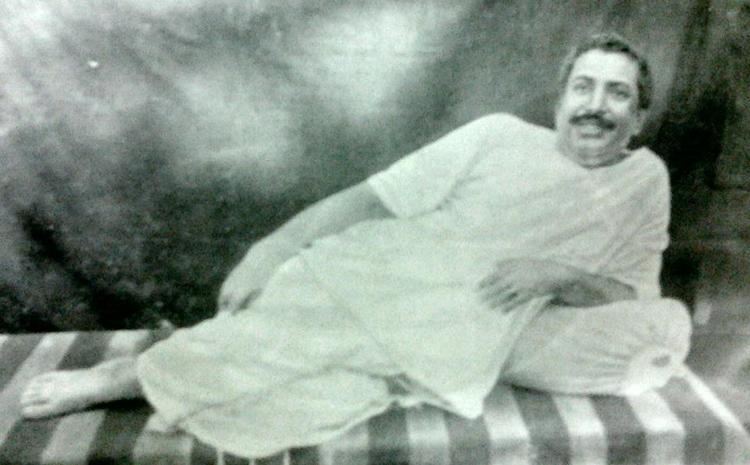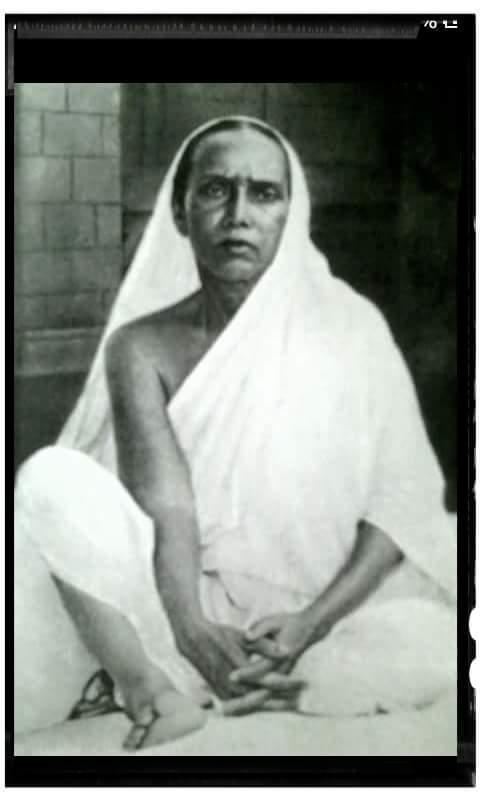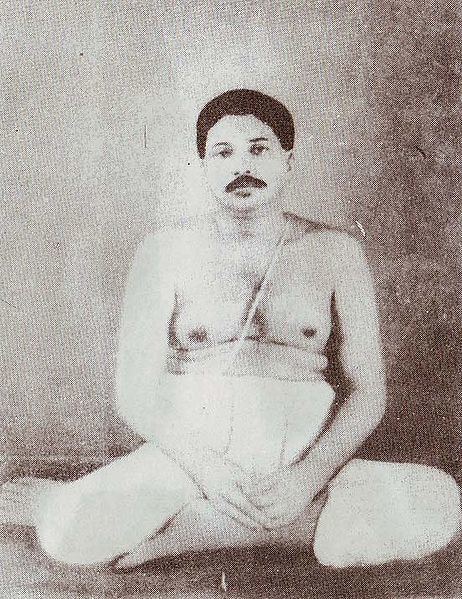Religion Hinduism Nationality Indian | Founder of Satsang Guru Huzur Maharaj | |
 | ||
Born Anukulchandra Chakravarty14 September 1888Himaitpur village (present-day Pabna district, Bangladesh) ( 1888-09-14 ) Spouse Sree Sree Boro Ma(Sorashibala Devi) Children Anuka Devi, Amarendranath Chakravarty Parents Shibchandra Chakravarty, Manmohini Devi Similar Nigamananda Paramahansa, Ram Thakur, Ramakrishna, Lokenath Brahmachari, Swami Vivekananda | ||
Sree Sree Thakur Anukulchandra (Bengali: শ্রীশ্রীঠাকুর অনুকূলচন্দ্র; 14 September 1888 – 27 January 1969) popularly known as Sree Sree Thakur, Bengali: শ্রীশ্রীঠাকুর) was an Indian God man, physician, and founder of Satsang. His followers consider him the latest incarnation of God as Lord Rama, Lord Krishna, Lord Buddha, Lord Jesus, Prophet Mohammad, Sri Chaitanya, Sri Ramakrishna.
Contents
- Birth and childhood
- Education
- Marriage
- Medical practice
- Kirtan and trance
- Man Making Mission
- Philanthropic activities at Satsang
- Moving to Deoghar
- Death and legacy
- Philosophy and teachings
- Literature
- Books
- Notable people influenced by Anukulchandra
- Satsang Centers and Bihars
- Commemorative postage stamp by Indian Government
- References

He was homeopathic physician by profession. Anukulchandra's social movement, called Satsang, was originally registered in Himaitpur. Later Satsang was registered as a society under Indian Societies Registration Act 1860, having its registered office at 57 Jatindra Mohan Avenue, Kolkata-57 and the main institution at Satsang Nagar, Deoghar, in the state of Jharkhand, India.

On 2 September 1946 before the Partition of India, Anukulchandra moved to Deoghar in India from his birthplace Himaitpur, Pabna. This is where Satsang currently has its main center. Anukulchandra died on 27 January 1969. Satsang is managed now by Sri Asoke Chakravarty (popularly called Sree Sree Dada), the grandson of Anukulchandra.

Birth and childhood

Anukulchandra was born on September 14, 1888 (Bhadra 30th, 1295 of Bengali Calendar) in Himaitpur village in the Pabna district of Bangladesh. His father was Sivachandra Chakravarty (Shandilya gotra Kanyakubja Brahmin) and his mother was Manomohini Devi. Biographers point out that Manomohini had strong spiritual thirst from the early childhood and had received the 'holy name' in her dream and later she had her formal initiation to 'holy name' from Radha Soami movement's guru Hazur Rai Saligram Bahadur.

According to followers, one day a wandering monk came to the homestead of his parents. The monk requested for a meal. After having the meal served by Manomohini Devi, the monk told Manomohini that the only male child of the family would die and a person would be born who would be a Lord to many. Soon after, Loha, the only brother of Manomohini died.
Anukulchandra was born in the 12th month of his mother's pregnancy. Allegedly, at birth he was smiling and looking around brightly at the world. Biographies of Anukulchandra also point out other unusual features and stories of birth such as having no hair on the head and extremely bright light in the home when Anukulchandra was born, which made villagers, fishermen come rushing from the Padma river thinking mistakenly that there was a fire.
According to many biographies, Anukulchandra's conduct and behavior was a little unusual and mysterious in nature from early childhood. Anukulchandra's extreme devotion to his mother was noted as one unusual characteristics. One math exam day, being late to prepare to go to school, Anukulchandra's mother angrily told him that he would not be able to answer a single math question. At exam, he did not write a single answer thinking, that would prove his mother wrong. Another unusual characteristics was noted as his prophesies. When asked by his mother to come along to go to see a newborn of their neighbor, four year old Anukulchandra told his mother that no need to go as newborn would die within eighteen days. The newborn allegedly died on eighteenth day.
Since childhood, Anukulchandra was believed to be able to sense the pain of others. One tropical stormy day from school, eight year old Anukulchandra started running, out of classroom through the bamboo groves while heavy hail was hitting him, protecting his head by text books, finally spotted a very old man in feeble voice crying for help- 'Allah, save me...'. He rescued the old man. Anukulchandra was chastised by mother Manomohini, since he came home in bad weather fully drenched and text books were damaged.
Biographies point out stories of Anukulchandra's fundamental thking ability as he was learning as a child. Anukulchandra was reportedly beaten heavily by his elementary school teacher Satya Moitra when he answered that one plus one only makes two ones but not two. Addition supposes that two things are identical which is non-existent.
Spiritual ecstasy from childhood was thought by the family and neighbor to be epileptic seizures. Having engrossed in meditating the 'holy name' given by his mother, Anukulchandra used to lose his outward consciousness on regular basis from the early childhood.
Education
Anukulchandra started his formal education at Himaitpur village elementary school in 1893. In 1898, he was admitted to Pabna Institute and studied there up to the eighth grade. He attended Raipur High School at Amirabad for a short period and then in Naihati High School in the 24 Parganas of West Bengal until 1905. He did not however graduate from high school. Biographies mention an incident where Anukulchandra gave away his matriculation exam registration fees to a classmate, who he found crying as he was not able to afford the registration fees.
Later Anukulchandra was admitted to the National Medical School of Bow Bazar in Calcutta. Anukulchandra tested-out of the school's high school diploma requirement.
In high school, Anukulchandra wrote several short plays, the first in 1905. He also wrote songs and poems which were later published in a book, Debjani-O-Anyanya. In 1910, Anukulchandra wrote some guiding instructions for one of his friend Atulchandra Bhattachariya, that was later published in 1918 as booklet called Satyanusaran (The Pursuit of Truth).
Marriage
At the age of 18 in the year 1906 (Bengali year 1313 on 28th day of Shrabana), Anukulchandra's parents arranged for him to marry Sorashibala, aged 11, daughter of Ramgopal Bhattacharya of Dhopadaha village, residing in Pabna town. Anukulchandra credited much of his success in life to his wife, mentioning that if he had been born as a woman, it would have been as his wife.
Medical practice
After finishing medical school, Anukulchandra started practicing medicine in Himaitpur in 1912. He practiced as a physician for only 3 years. His reputation as a physician spread in the neighboring towns and villages due to reports of a miraculous curing ability. Anukulchandra reportedly paid for his patients' medicine and provided financial help. Anukulchandra did not have a fixed rate for seeing patients and he accepted fruits and vegetables as payment for his services.
Kirtan and trance
At the height of his success as a physician, Anukulchandra formed kirtan group which attracted whole host of people from all strata of the society. There are reports that claim that many of the outcast in the society like drug addicts, convicted killers, etc. came to his kirtan group and transformed into a normal human being. Anukulchandra's fame slowly turned from being just a 'wonderful physician' to a friend, a guide and a shelter. Anukulchandra at this time had started having formal devotee by the process of 'Initiation' (Bengali: দীক্ষা) in the 'Holy Name' that he had received from his own mother in the childhood. Ananta Maharaj, Kishori Mohan Das and Satishchadra Goswami were his first three initiated devotees.
In the years between 1914 and 1919, Anukulchandra, while performing kirtan went into trance. It is said that during these episodes of trance, utterances would come out of his mouth. The people around him started recording those messages and 71 days of such messages was later published as a book called 'Holy Book' (Bangla পুন্যপুথি). The messages of these episodes has claims of his Providence. During this period of trance Anukulchandra's fame as a divine personality spread all over Bengal. People from all over India started coming to see a glimpse of Anukulchandra. Many of them were repeat visitors and eventually moved to Himaitpur to stay with Anukulchandra.
As the followers grew and started living around him, in the year 1915, Anukulchandra's mother gave a name to the movement as 'Satsang'.
Man Making Mission
At the end of 1919, at the height of his fame with kirtan and trance one evening Anukulchandra disappointed a mammoth crowd by not doing kirtan. Anukulchandra started his new mission called 'labor of love'. With thousands of devotees living around him, Anukulchandra started his 'man making mission' with three guiding principles of 'Jajan', 'Jaajan' and 'Ishtavrity'.
Philanthropic activities at Satsang
Anukulchandra set up Tapovan Vidyalaya and a number of Arts and Science colleges to provide education to the community. He setup the research laboratory called Viswa Vigyan Kendra. To promote fine arts Anukulchandra started the Satsang Kala Kendra. Gradually findings and learning were recorded in various books.
Moving to Deoghar
On 2 September 1946, Anukulchandra, at the age of 58, went to Deoghar with few of his devotees and family members owing to poor health. Soon after he went to Deoghar, India gained independence from the British Empire, but was also partitioned. The Himaitpur Satsang became part of what is now Bangladesh. He rebuilt the institution at Deoghar, Jharkhand.
Death and legacy
After his death on 27 January 1969, his oldest son Amarendranath Chakravarty (21 November 1911 – 6 August 1995), known as Sree Sree Borda (Bengali: শ্রীশ্রীবড়দা), led the activities of Satsang as the Acharya (one who demonstrates the way through his practices). He was a key figure in the maintenance of Satsang movement after Sree Sree Thakur's demise in 1969. He was credited with the rapid expansion of Satsang followers and as well building of numerous Satsang centres in different parts of India.
Today the activities are headed by Asoke Chakravarty, grandson of Anukulchandra and son of Amarendranath Chakravarty.
Philosophy and teachings
Literature
With the exception of a few brief plays, poems, and songs collected in "Debojani O Ananya," the sole work directly authored by Anukulchandra is "Satyanusaran." His spoken rhymes have been compiled into several volumes by the Satsang Publishing House, founded by Anukulchandra himself. Additionally, numerous discussions and lectures given by Anukulchandra were documented by designated followers and have subsequently been published.
Books
Books in Bengali (Original Work)
- Satyanusaran (Pursuit of Truth)
- Swasthya O Sadachar Sutra (Health & Hygiene)
- Yati Abhidharma (Upholding principles to be followed by a Saint)
- Debi-Sukta (On Women)
- Tapa-Bidhayana 2 Vol. (Rules of Spiritual Practices)
- Bidhi-Binyas (Application of Rules)
- Sad-Bidhayana (Rules of Embodiment of Truth)
- Nistha-Bidhayana (Rules of Adherence)
- Adarsha-Binayaka (Rules of Ideal)
- Bidhan-Binayaka (Existential Laws)
- Samaj-Sandipana (Guidance for society)
- Bikriti-Binayana (Adjustment of Adulteration)
- Bigyan-Bibhuti (Scientific Knowledge)
- Dhriti-Bidhayana 2 Volumes (Maintenance of Knowledge)
- Achar-Charjya 2 Volumes (Rules of Conduct)
- Alochana-Prasange 22 Volumes (Discussions)
- Nana-Prasange 4 volmes. (Conversation on various Subjects)
- Katha-Prasange 3 Volumes (Discourses)
- Islam-Prasange (About Islam)
- Punya-Punthi (Holy Book)
- Anushruti 7 volmes (Rhymes and poetry)
- Chalar-Saathi (Companion of Life)
- Pather-Kari (Gems for Life)
- Nareer-Neeti (Women's Code)
- Seva-Bidhayana (Rules for Service)
- Neeti-Bidhayana (Moral Principles)
- Kriti-Bidhayana (Rules for Success)
- Shiksha-Bidhayana (Educational Principle)
- Darshan-Bidhayana (Philosophical Principle)
- Nareer Pathe (Women's Guidance)
- Shaswati (Eternal Truths)
- Sambitee (Perfect Knowledge)
- Taanr-Chithi (Letter written by Anukulchandra)
- Amiya-Lipi (Solution of daily life problems)
- Ashish-Banee 2 Volumes (Blessings)
- Preeti-Binayak 2 Volumes (About Love)
- Jaji-Sukta (Principles of Jaajan)
- Charyya-Sukta (Habit)
- Bibaha-Bidhayana (Marriage)
- Sangya-Samiksha (Definition)
- Bibidha-Sukta (Rules)
- Arya-Pratimokshya (Aryan Culture)
- Deeprakshi (Conversations)
- Jeevan Dipti 3 Volumes (Enlightenment of Life)
- Arya-Kristi (Aryan Culture)
- Amiya Bani (Valuable Principles)
Books in English (Original Work)
- The Message 9 Volumes
- Magnadicta
- Lord’s Prayer
- Discourses
Notable people influenced by Anukulchandra
Chittaranjan Das, Krishna Prasanna Bhattacharya (assistant to Nobel Laureate Prof C.V.Raman), and Barin Ghosh have been initiated as disciples of Anukulchandra. Subhas Chandra Bose was also strongly influenced by Anukulchandra's philosophy.
Satsang Centers and Bihars
Satsang Centres (places where devotees assemble regularly) are present in multiple places around the world (US, Canada, UK, Australia, Singapore, UAE, Nepal, Myanmar, Bangladesh, India). Satsang Bihars are present in many states of India (Gujarat, West Bengal, Assam, Tripura, Orissa, Delhi, Tamil Nadu, Andhra Pradesh, Karnataka, Maharashtra to name a few).
Commemorative postage stamp by Indian Government
On 2 September 1987 (100th anniversary) of Sree Sree Thakur, Government of India has released a postage stamp on Him.
